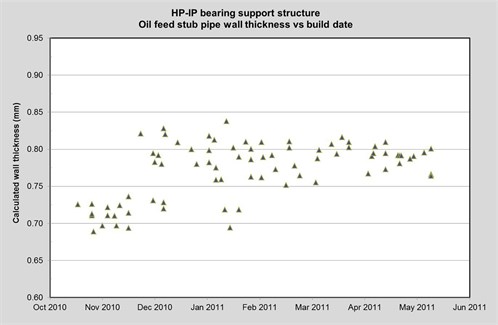Numerous other engines within the Trent 900 fleet were also found to contain a critical reduction in the oil feed stub pipe wall thickness.
In December 2010, in response to this safety issue, Rolls-Royce focussed on assessing the oil feed stub pipe counter bore geometries across the Trent 900 engine fleet. Following a stress analysis and numerical modelling of the stub pipe counter bore geometry, a minimum calculated stub pipe wall thickness acceptance limit of 0.5 mm was established in order for engines to remain in service. Any engine with a stub pipe thickness below this limit was removed from service. Wall thicknesses were established across the fleet using either:
- a specialist boroscope visual inspection and measurement of the oil feed stub pipe counterbore (NMSB 72-G595)
- examination of a ‘replicast’ (a rubber-like mould) of the oil feed stub pipe’s internal features (Technical Variance 108953)
- a boroscope inspection to identify the serial numbers of relevant HP/IP bearing support structures fitted to Trent 900 engines (NMSB 72-643)
- existing manufacturing data.
The borescope inspection technique introduced by NMSB 72-G595 was successful in identifying in-service oil feed stub pipes with reduced wall sections. However, based on the results, the tolerances were not sufficient to provide confidence for accurate service management.
The available manufacturing data was analysed by Rolls-Royce from early December 2010 to calculate the oil feed tube wall thickness in some B-standard HP/IP bearing support structures and all C-standard structures. Rolls-Royce elected to withdraw all of the A-production standard HP/IP bearing support structures due to their manufacturing records being unavailable.
As a result of this action, 40 engines were removed from service having been identified with an oil feed stub pipe wall thickness of less than 0.5 mm. This resulted in the removal from service of the following engines:
- 14 engines with an A-production standard HP/IP bearing support structure
- 23 engines with a B-production standard HP/IP bearing support structure. Of these, five were removed from Qantas-operated A380 aircraft
- 3 engines with a C-production standard HP/IP bearing support structure.
Following the occurrence, the stub pipe wall thickness production limit was restricted to 0.70 mm for all newly manufactured engines (Figure 93). The revised limit was introduced in December 2010, along with enhanced techniques for the measurement of critical dimensions within the counter bore region.
Rolls-Royce production data showed that, after the introduction of this revised limit in December 2010, the quality control of the manufacture of the HP/IP bearing support structure at the Hucknall facility had improved (Figure 93).
Figure 93: Production data for the HP/IP bearing support structures that were manufactured at the Hucknall facility

The ATSB is satisfied that the action taken by Rolls-Royce adequately addresses this safety issue and therefore makes no recommendation.


